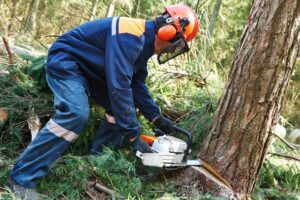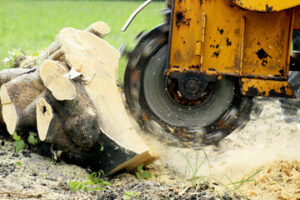Tree Service Irvine CA is a dangerous task and should be left to the professionals. However, if you’re willing to take the risk, there are some things you should know about this process.
First, find out where the tree is going to fall. This will help prevent injury or damage to your home or power lines.

The safety of tree cutting is a major concern for anyone who does this job. It’s important to be familiar with the risks and how to avoid them. In addition to falling trees, there are also dangers from equipment and power lines that may be damaged. This is why it’s always best to hire a professional tree service for this type of work.
A hazard analysis should be performed before starting any climbing or cutting. This should include visually inspecting the tree, looking for cracks and cankers, and signs of disease or rot. It’s also a good idea to note any uneven growth and leaning of the trunk, as well as the presence of invasive species like poison ivy. A hazard assessment should also take into account the weather conditions, as high winds or fog can make it more difficult to climb.
If the tree is on a power line, you should contact the power company to have it cleared before beginning the cut. A backup plan is essential in case things don’t go according to plan, and it should include at least two escape routes. It’s a good idea to have a partner on hand in case you need help or direction. In addition, you should wear a hard hat, eye protection, and chainsaw pants that don’t jam chains.
When working with a ladder, it’s important to use a tall one in the correct position. This way, you won’t be too close to the branch you’re trying to cut. In addition, you should use a safety harness and rope, as well as a lanyard or sling, to keep yourself secured. Finally, ensure appropriate climbing equipment, including a helmet and shoes that grip slippery surfaces.
Before making the final cut, you should use a directional notch to control the direction of the fall. This consists of two separate cuts that remove a triangle-shaped portion of the bark and, when done correctly, will determine the direction the tree falls when it’s felled. Make sure the notch is placed on the side of the tree facing the direction you want it to fall and that it’s at least one-third of the way into the trunk.
From an early age, many of us are told that cutting down trees harms the environment. We see images of wildlife losing their forest homes and hear about large swathes of rainforest being cleared for paper and wood products. These things are true, but there are also responsible ways to use trees and forests without damaging the ecosystem and the environment. Tree cutting can benefit the environment in some surprising ways.
For example, a single tree can remove about 50 pounds of pollution from the air in its lifetime. This makes it important to keep healthy trees on your property or near your home. This is especially true if you live near a highway, where traffic fumes can be harmful. Trees also help other plants by transferring nutrients to them, so removing them can harm the health of surrounding vegetation.
In addition to preventing soil erosion, trees can provide shade and block out excessive sunlight. This can protect people from sunburn and heat damage, as well as help reduce the temperature in your home. This is particularly important for people with asthma or other respiratory illnesses. However, a person can experience a variety of other health problems from too much direct sunlight, including eye diseases, skin cancer, and heart disease.
Forests are also vital to the Earth’s water cycle. They store massive amounts of carbon and water, helping to reduce greenhouse gases and balance the climate. Deforestation, conversely, can harm the climate, as it releases carbon dioxide into the atmosphere and contributes to global warming.
Aside from carbon dioxide storage, deforestation can cause several other environmental impacts. For example, the open areas that result from deforestation make it easier for insects to survive and thrive. These insects are often the carriers of parasites, leading to serious illnesses in humans. These parasites include flatworms, which cause schistosomiasis.
While there are a few situations when it’s necessary to cut down trees, most of the time, tree cutting is done for safety reasons. For instance, a tree may be growing too close to the road, or it could fall over in a storm, causing property damage and injury to people. This type of tree cutting is important to prevent these hazards, and it’s a good idea to hire an expert tree cutter for this job.
The law governing tree cutting varies from state to state, but it is generally illegal to cut down or trim a neighbor’s trees without permission. It is also a crime to damage a neighbor’s property by cutting down or trimming the tree, so you should avoid doing this. Instead, it would be best to work with your neighbor to devise a mutually beneficial solution. This could include pruning the tree to reduce size or removing branches causing problems. If you can’t come to a resolution, you may need to take legal action.
If a tree is located on the boundary line between two properties, it belongs to whoever owns the land it grows on. However, the owner can trim it if its branches infringe on the other property. Similarly, a homeowner can prune and remove roots that encroach on pipes or foundations on their property. However, the encroaching roots or branches must be carefully trimmed so the tree does not suffer.
Cutting down a tree on another person’s property without their permission can lead to lawsuits and damages. For example, New York state law states that anyone who cuts down a tree on another person’s land can be liable for up to triple the stumpage value of the trees and timber cut. The injured party can also claim separate damages for any physical or financial damage caused by the violation.
Arboriculture law is complex and varies from country to country and state to state. This is why it’s important to research local laws before attempting any landscaping or tree work. In addition, local government officials can inspect and monitor private forests to ensure they comply with environmental regulations.
It’s also important to check whether a person is licensed to do tree work in their area. Some states require a license for landscape work, while others require a permit to cut down trees. A person who doesn’t have a license or permit can be fined or even jailed for doing so.
Whether you’re pruning an overgrown tree or need to remove one, it can be very expensive. It’s important to hire a tree-cutting service that can provide you with the right price and services. While some companies may be more costly than others, it’s usually worth it in the long run. A professional company will also ensure the job is done correctly, and you’ll avoid costly repairs down the road.
It’s important to know the best time of year to cut trees and shrubs. For instance, ornamental shrubs should be cut yearly to keep their shape and prevent misgrowth. Fruit trees should be pruned every four to six years, while young trees should be pruned more frequently. This will help them grow healthily and prevent disease or insect infestations from spreading to nearby trees.
Cutting trees is an essential part of forest management and helps maintain biodiversity. It’s also a great renewable energy source, which we need to fuel our growing global population. In addition, the wood that we harvest provides wildlife habitats, shapes forests for the future, and generates revenue for forest owners. In addition, new technologies make it possible to use wood for more than just lumber and paper. This is why it’s important to support the timber industry.
In contrast, clear-cutting is destructive to forest ecosystems and decreases biodiversity. It also leads to soil erosion and increases the risk of sediment and nutrient leakage into water bodies. It also interferes with the water cycle by reducing evapotranspiration, a process by which trees release moisture into the atmosphere.
Moreover, it can have serious health consequences for humans. It can affect a person’s lung capacity and lead to respiratory problems. In addition, it can cause a variety of other problems. According to Dr. Sushrut Babhulkar, director of the Respira Chest and Critical Care Hospital, cutting trees more than 75 years old is a bad idea because it can affect the respiratory system of people. Moreover, these trees provide a lot of fresh air and should be saved.
